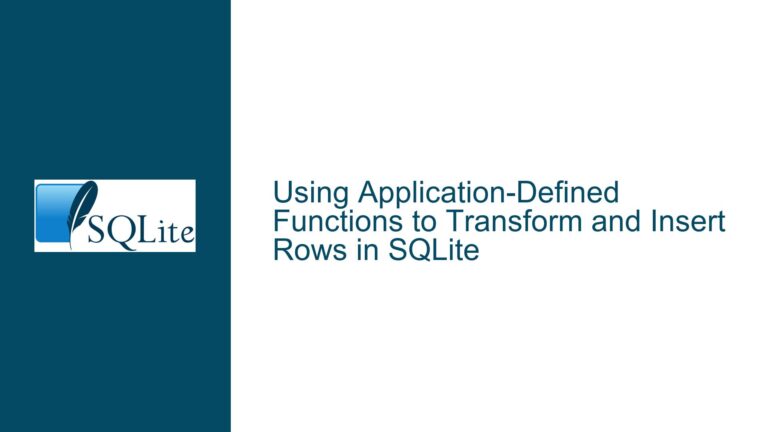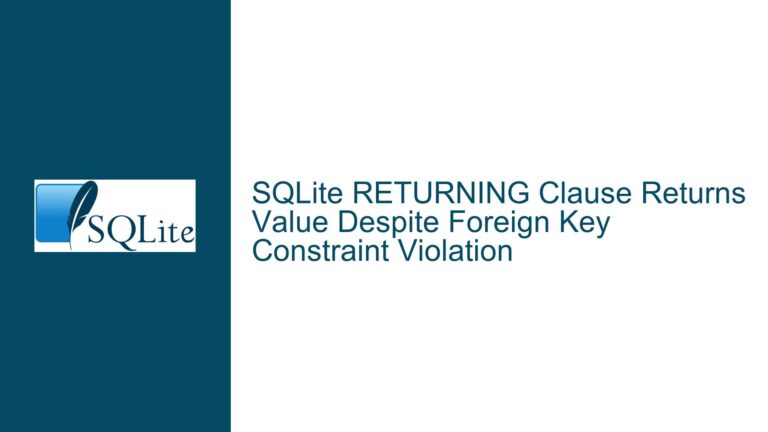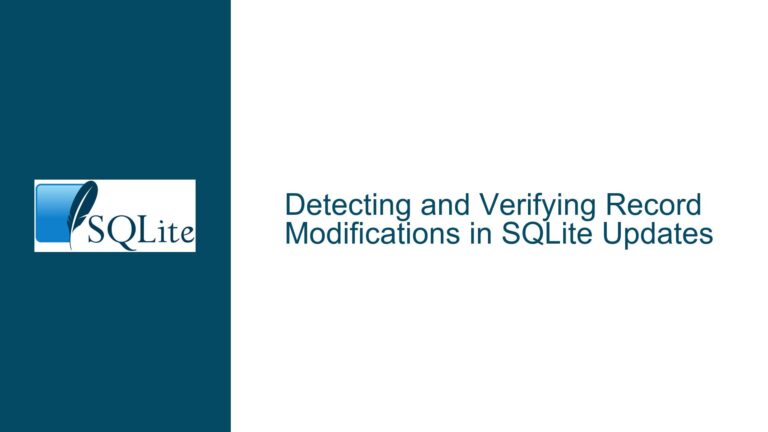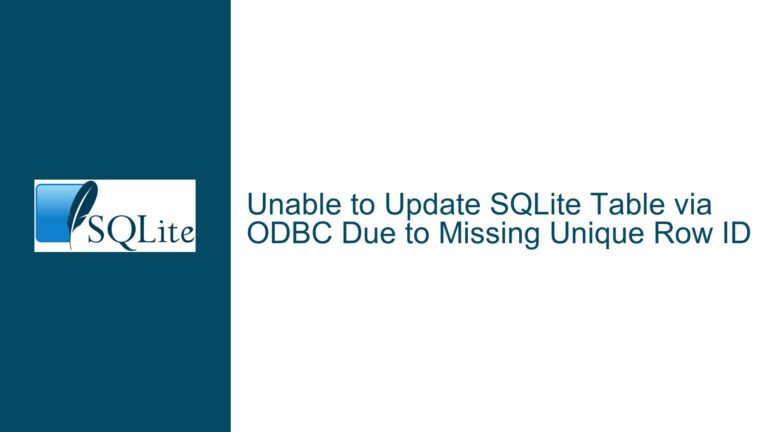INSERT OR IGNORE Behavior in SQLite with STRICT Tables
Issue Overview: INSERT OR IGNORE Fails with STRICT Type Enforcement
The core issue revolves around the behavior of the INSERT OR IGNORE statement in SQLite when used with a table that has strict type enforcement enabled via the STRICT keyword. In the provided example, a table t0 is created with a single column c0 of type INT and the STRICT keyword applied. An attempt is made to insert a REAL value (1.1) into this INT column using the INSERT OR IGNORE statement. Contrary to the expectation that the IGNORE clause would suppress the error, a runtime error is thrown: cannot store REAL value in INT column t0.c0 (19).
The confusion arises from the misunderstanding of what the IGNORE clause in INSERT OR IGNORE is designed to handle. The IGNORE clause is specifically intended to suppress errors related to unique constraint violations, not all types of errors. In this case, the error is a type enforcement error caused by the STRICT table mode, which strictly enforces column types and does not allow implicit type conversions. This behavior is distinct from unique constraint violations and thus is not suppressed by the IGNORE clause.
Possible Causes: Misalignment Between IGNORE Clause and STRICT Type Enforcement
The primary cause of the issue lies in the misalignment between the intended use of the IGNORE clause and the strict type enforcement mechanism introduced by the STRICT keyword in SQLite. The IGNORE clause is designed to handle specific types of errors, primarily those related to unique constraint violations. When a unique constraint violation occurs, the IGNORE clause instructs SQLite to skip the insertion of the offending row without raising an error. However, this mechanism does not extend to other types of errors, such as type enforcement errors.
The STRICT keyword, introduced in SQLite version 3.37.0, enforces strict type checking on table columns. When a table is created with the STRICT keyword, SQLite will reject any attempt to insert a value of a type that does not match the declared column type. In the example, the column c0 is declared as INT, and the STRICT keyword ensures that only integer values can be stored in this column. When a REAL value (1.1) is attempted to be inserted, SQLite raises a type enforcement error because the value does not conform to the column’s type requirements.
The misunderstanding likely stems from the assumption that the IGNORE clause would suppress all types of errors, including type enforcement errors. However, this is not the case. The IGNORE clause is narrowly scoped to handle unique constraint violations and does not interact with the type enforcement mechanism introduced by the STRICT keyword. As a result, the type enforcement error is raised, and the insertion fails.
Troubleshooting Steps, Solutions & Fixes: Aligning Expectations with SQLite Behavior
To address this issue, it is essential to align expectations with the actual behavior of SQLite’s INSERT OR IGNORE statement and the STRICT type enforcement mechanism. Below are detailed steps and solutions to troubleshoot and resolve the issue:
1. Understanding the Scope of the IGNORE Clause
The first step in troubleshooting this issue is to understand the scope of the IGNORE clause in the INSERT OR IGNORE statement. The IGNORE clause is specifically designed to handle unique constraint violations. When a unique constraint violation occurs, the IGNORE clause instructs SQLite to skip the insertion of the offending row without raising an error. This behavior is useful in scenarios where duplicate entries are expected, and the goal is to avoid raising errors when such duplicates are encountered.
However, the IGNORE clause does not suppress other types of errors, such as type enforcement errors, foreign key constraint violations, or not null constraint violations. In the case of type enforcement errors, the STRICT keyword ensures that only values of the correct type can be inserted into a column. If an attempt is made to insert a value of an incorrect type, SQLite will raise a type enforcement error, and the IGNORE clause will not suppress this error.
To avoid confusion, it is important to recognize that the IGNORE clause is not a catch-all mechanism for suppressing all types of errors. Instead, it is a targeted solution for handling unique constraint violations. When working with STRICT tables, it is necessary to ensure that all inserted values conform to the column types to avoid type enforcement errors.
2. Handling Type Enforcement Errors in STRICT Tables
When working with STRICT tables, it is crucial to ensure that all inserted values conform to the declared column types. In the example, the column c0 is declared as INT, and the STRICT keyword enforces that only integer values can be stored in this column. To avoid type enforcement errors, it is necessary to ensure that all values inserted into c0 are of type INT.
One approach to handling this issue is to validate the data before attempting to insert it into the table. This can be done using application-level logic or SQLite’s built-in functions. For example, the CAST function can be used to explicitly convert a value to the desired type before insertion. If the conversion fails, the insertion can be skipped or handled appropriately.
In the example, the value 1.1 is a REAL value, and attempting to insert it into an INT column results in a type enforcement error. To avoid this error, the value can be explicitly cast to an INT using the CAST function:
INSERT OR IGNORE INTO t0 VALUES(CAST(1.1 AS INT));
However, it is important to note that casting a REAL value to an INT will result in the fractional part being truncated. In this case, the value 1.1 will be truncated to 1, which may or may not be the desired behavior depending on the application’s requirements.
Another approach is to use a CHECK constraint to enforce type compliance at the table level. A CHECK constraint can be added to the table definition to ensure that only values of the correct type are inserted. For example:
CREATE TABLE t0(c0 INT CHECK(TYPEOF(c0) = 'integer')) STRICT;
This CHECK constraint ensures that only values of type integer can be inserted into the c0 column. If an attempt is made to insert a value of a different type, the insertion will fail, and an error will be raised. This approach provides an additional layer of type enforcement and can help prevent type enforcement errors.
3. Alternative Approaches to Handling Type Enforcement Errors
In some cases, it may be necessary to handle type enforcement errors in a more flexible manner. For example, if the application needs to insert values of different types into a column, it may be necessary to relax the type enforcement or use a different approach to handle the data.
One alternative approach is to use a TEXT column instead of an INT column. A TEXT column can store values of any type as strings, and the application can handle the conversion and validation of the data. For example:
CREATE TABLE t0(c0 TEXT) STRICT;
INSERT OR IGNORE INTO t0 VALUES('1.1');
In this case, the value 1.1 is stored as a string in the c0 column. The application can then handle the conversion of the string to the desired type as needed. This approach provides greater flexibility but requires additional logic to handle the conversion and validation of the data.
Another alternative approach is to use a JSON column to store the data. SQLite’s JSON support allows for the storage of structured data, including values of different types. For example:
CREATE TABLE t0(c0 JSON) STRICT;
INSERT OR IGNORE INTO t0 VALUES(json('1.1'));
In this case, the value 1.1 is stored as a JSON value in the c0 column. The application can then handle the extraction and conversion of the JSON value as needed. This approach provides even greater flexibility but requires additional logic to handle the JSON data.
4. Best Practices for Using STRICT Tables and INSERT OR IGNORE
To avoid issues with type enforcement errors and the INSERT OR IGNORE statement, it is important to follow best practices when working with STRICT tables. Below are some best practices to consider:
Understand the Scope of the IGNORE Clause: Recognize that the
IGNOREclause is designed to handle unique constraint violations and does not suppress other types of errors, such as type enforcement errors. Use theIGNOREclause only when dealing with unique constraint violations.Validate Data Before Insertion: Ensure that all values inserted into
STRICTtables conform to the declared column types. Use application-level logic or SQLite’s built-in functions to validate and convert data as needed.Use CHECK Constraints for Additional Type Enforcement: Consider using
CHECKconstraints to enforce type compliance at the table level. This provides an additional layer of type enforcement and can help prevent type enforcement errors.Consider Alternative Data Types: If the application needs to handle values of different types, consider using a
TEXTorJSONcolumn to store the data. This provides greater flexibility but requires additional logic to handle the conversion and validation of the data.Test and Validate Schema Changes: When making changes to the schema, such as adding the
STRICTkeyword or modifying column types, thoroughly test and validate the changes to ensure that they do not introduce unexpected issues.
By following these best practices, it is possible to avoid issues with type enforcement errors and ensure that the INSERT OR IGNORE statement behaves as expected when working with STRICT tables in SQLite.
5. Conclusion
The issue of the INSERT OR IGNORE statement failing with a type enforcement error in a STRICT table highlights the importance of understanding the scope and limitations of SQLite’s features. The IGNORE clause is designed to handle unique constraint violations and does not suppress other types of errors, such as type enforcement errors. When working with STRICT tables, it is crucial to ensure that all inserted values conform to the declared column types to avoid type enforcement errors.
By validating data before insertion, using CHECK constraints, considering alternative data types, and following best practices, it is possible to avoid issues with type enforcement errors and ensure that the INSERT OR IGNORE statement behaves as expected. Understanding the nuances of SQLite’s behavior and aligning expectations with its features is key to successfully working with STRICT tables and other advanced SQLite features.






